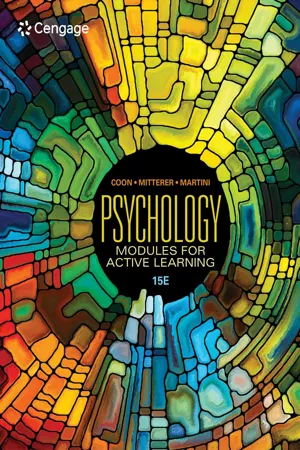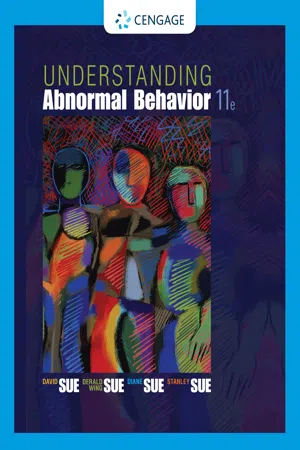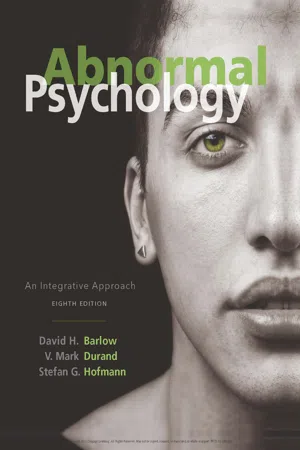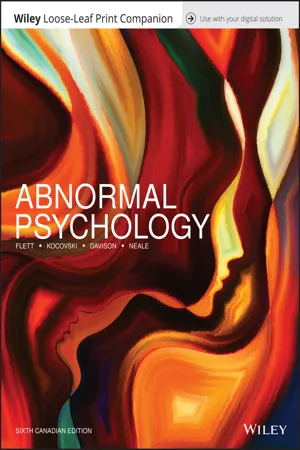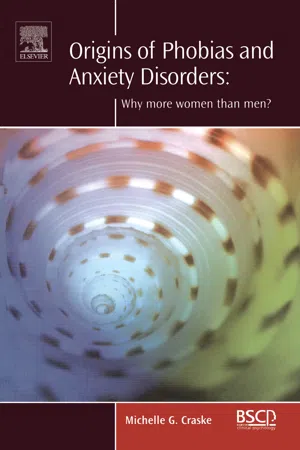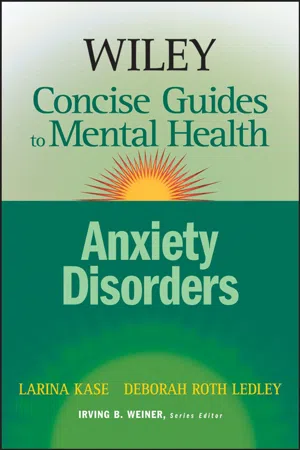Psychology
Anxiety Disorders
Anxiety disorders are a group of mental health conditions characterized by excessive worry, fear, and apprehension. Common types include generalized anxiety disorder, panic disorder, social anxiety disorder, and specific phobias. Symptoms can range from mild to severe and may significantly impact daily functioning. Treatment often involves a combination of therapy, medication, and lifestyle changes.
Written by Perlego with AI-assistance
Related key terms
1 of 5
12 Key excerpts on "Anxiety Disorders"
- eBook - PDF
- Nancy Ogden, Michael Boyes, Evelyn Field, Ronald Comer, Elizabeth Gould(Authors)
- 2021(Publication Date)
- Wiley(Publisher)
644 CHAPTER 15 Psychological Disorders Stockbyte/Getty Images Feeling anxious Anxiety is a normal part of life—everyone feels anxious sometimes. Anxi- ety becomes a problem when it interferes with a person’s ability to participate fully in society. Some people suffer such disabling levels of fear and anxiety that they cannot lead a normal life (see photo). Their discomfort is too severe or too frequent; it lasts too long; or it is triggered too easily. These people are said to have an anxiety disorder. Anxiety Disorders are collectively the most common mental disorders in Canada. In any given year, about 12 percent of the adult population suffers from one or another of the Anxiety Disorders identified by DSM-5 (Ruscio et al., 2017; Louise, O’Donnell Siobhan, & Jean, 2017; O’Donnell et al., 2016; Kessler et al., 2012). There are several kinds of Anxiety Disorders. Individuals with generalized anx- iety disorder experience persistent feelings of worry and anxiety. People with social anxiety disorder display persistent fears of social or performance situations. People with phobias have a persistent and irrational fear of a specific object, activity, or situation. Individuals with panic disorder have recurrent attacks of terror. Those with obsessive-compulsive disorder feel overrun by recurrent thoughts that cause anxiety or by the need to perform repetitive actions to reduce anxiety. And those with posttraumatic stress disorder (PTSD) are tormented by overwhelming intrusive fears about the horrors associated with the traumatizing event—even when the event is long over and they are otherwise safe and well. Most individuals with one anxiety disorder suffer from a second one as well (Goldstein-Piekarski, Williams, & Humphreys, 2016; Miloyan et al., 2016). In the above example, Bob experiences the excessive worry found in generalized anxiety disorder, as well as the repeated attacks of terror that mark panic disorder. - eBook - PDF
Introduction to Psychiatry
Preclinical Foundations and Clinical Essentials
- Audrey Walker, Steven Schlozman, Jonathan Alpert(Authors)
- 2021(Publication Date)
- Cambridge University Press(Publisher)
6 Anxiety Disorders MEREDITH CHARNEY, ERIC BUI, ELIZABETH GOETTER, CARL SALZMAN, JOHN WORTHINGTON, LUANA MARQUES, JERROLD ROSENBAUM, AND NAOMI SIMON The Spectrum of Anxiety Disorders Classification Anxiety is a common human emotion and is experienced by all people at some point in life. It is characterized by a state of apprehension about a perceived threat or potentially dangerous situation. In addition, fear is a negative emotion caused by the belief that someone or something is dangerous, likely to cause pain, or a threat. At mild to moderate levels, anxiety can be adaptive, motivating, and can help improve performance and attention. For example, prior to a significant life event such as an important test or presentation, some individuals may expe- rience anxiety, which could serve as a motivator to work harder and perform better. Similarly, fear can be an adaptive response when one is confronted with a life-threatening situation, and a fight or flight response to danger is present and adaptive across many animal species. However, for some, anxiety or fear may be overwhelming, distressing, and interfere with functioning. This may require a per- son to seek treatment depending on the level of interference and could also result in the development of a psychiatric condition. According to the fifth edition of the Diagnostic and Statistical Manual of Mental Disorders (DSM-V), anxiety becomes a disorder when it reaches a level at which it interferes with social, occupational, or familial functioning or causes signifi- cant distress. When anxiety interferes with normal function, it can interfere with quality of life and contribute to other disorders. For example, someone who is persistently concerned about having a panic attack may avoid leaving their home to reduce the risk of having a panic attack in public. Avoiding going out could then result in job loss and isolation from friends and family, which could further worsen anxiety and other mood sequelae. - eBook - PDF
- Douglas Bernstein, , , (Authors)
- 2015(Publication Date)
- Cengage Learning EMEA(Publisher)
Copyright 2016 Cengage Learning. All Rights Reserved. May not be copied, scanned, or duplicated, in whole or in part. Due to electronic rights, some third party content may be suppressed from the eBook and/or eChapter(s). Editorial review has deemed that any suppressed content does not materially affect the overall learning experience. Cengage Learning reserves the right to remove additional content at any time if subsequent rights restrictions require it. 504 Psychological Disorders everyone has problems sometimes. Before deciding that you or someone you know has a serious disorder or needs psychological help, consider whether the content, context, and functional impairment associated with the behavior would qualify it as abnormal accord-ing to the criteria of the practical approach. Anxiety Disorders What is a phobia? If you’ve ever been tense before an exam, a date, or a job interview, you have some idea of what anxiety feels like. An increased heart rate, sweating, rapid breathing, dry mouth, and a sense of dread are all common features of anxiety. Brief episodes of moderate anxiety are a normal part of life for most people. But when anxiety is so intense and long-standing that it disrupts a person’s daily functioning, it can create Anxiety Disorders (Morrison & Heimberg, 2013). Types of Anxiety Disorders Here, we discuss three types of Anxiety Disorders: specific phobia, generalized anxiety dis-order, and panic disorder. Together, Anxiety Disorders are the most common psychological disorders in North America; about 29 percent of the adults and 25 percent of children and adolescents in the United States will have an anxiety disorder at some point in their lives (Kessler et al., 2009; National Institute of Mental Health, 2014). Phobia An intense, irrational fear of an object or situation that is not likely to be dangerous is called a phobia . DSM-5 includes the diagnoses of specific phobia, social anxiety disorder (social phobia) , and agoraphobia . - eBook - PDF
Psychology and the Challenges of Life
Adjustment and Growth
- Spencer A. Rathus, Jeffrey S. Nevid(Authors)
- 2019(Publication Date)
- Wiley(Publisher)
Anxiety is abnormal when it is excessive or when it comes out of nowhere—that is, when events do not warrant it. There are different types of anxiety-related disorders, but all of them are characterized by excessive or unwarranted anxiety. Anxiety-related disorders are quite common, affecting as many as three in ten of us (Merikangas et al., 2010; Torpy et al., 2011). We saw that the majority of college students report feeling “overwhelmed” by anxiety now and then (American College Health Association, 2018b). Types of Anxiety-Related Disorders The anxiety-related disorders shown in Figure 13.1 all involve disturbing levels of bodily arousal and worrying. Some of them involve fears of specific stimuli, such as spiders, heights, or social interactions (“stage fright”). Others occur in a variety of situations. Specific Phobic Disorders A specific phobic disorder is an excessive, irrational fear of a particular object or situation, such as snakes or heights. The disorder can severely impact one’s life. For example, one specific phobia is fear of elevators. Some people will not enter eleva- tors despite the hardships they incur as a result (such as walking up six flights of steps). Yes, the specific phobic disorder Persistent irrational fear of a specific object or situation that may impair a person’s physical, emotional, or social adjustment. Science Photo Library/Getty Images FIGURE 13.1 Disorders with Anxiety at the Core • Specific phobias • Social anxiety disorder • Panic disorder • Generalized anxiety disorder • Obsessive–compulsive disorder • Hoarding disorder • Stress disorders • Illness anxiety disorder 374 CHAPTER 13 Psychological Disorders cable could break. The ventilation could fail. One could be stuck in midair waiting for repairs. These problems are uncommon, however, and it does not make sense (to most people!) to walk up and down several flights of stairs to elude them. - Stephen F. Davis, William Buskist, Stephen F. Davis, William F. Buskist(Authors)
- 2007(Publication Date)
- SAGE Publications, Inc(Publisher)
262 80 A NXIETY D ISORDERS T ODD A. S MITHERMAN University of Mississippi Medical Center A nxiety disorders are highly prevalent in the general population and result in considerable suffering for millions of individuals. Consequently, much research has been conducted on the etiology, assessment, and treatment of Anxiety Disorders. Advances made within the field of Anxiety Disorders represent one of the great success stories within psychology over the last century. These advances demonstrate how empirical research and well-grounded theories can be used to inform clinical practice. For these reasons, Anxiety Disorders are of par-ticular interest to students of psychology, especially those considering a career in clinical psychology. THEORY Historical Overview Although Anxiety Disorders were not officially recog-nized by the American Psychiatric Association until 1980, anxiety and fear have always played prominent roles in human history. Civilizations have used chemical and herbal remedies to reduce fear and decrease pain for literally thousands of years. The ancient Greeks described citizens who were so fearful that they refused to leave their homes, a precursor to our modern concept of agoraphobia. Over the following centuries, civilizations attributed anxiety symptoms to the results of human sin or witchcraft, the work of evil spirits, or relatively crude assumptions about human biology. Beginning in the late 1800s, and coinciding with the spread of psychology to America, fear and anxiety began to receive closer attention within the academic community. Charles Darwin, who himself experienced extreme panic attacks and agoraphobia, observed that lower animals were capable of panic-like symptoms and would “play dead” when threatened. Darwin’s evolutionary theory suggested that fear was an adaptive behavior, conferring a survival advantage by facilitating escape from and avoidance of danger.- eBook - PDF
Psychology
Modules for Active Learning
- Dennis Coon, John Mitterer, Tanya Martini, , Dennis Coon, John Mitterer, Tanya Martini, (Authors)
- 2021(Publication Date)
- Cengage Learning EMEA(Publisher)
543 MODULE 63 PSYCHOLOGICAL DISORDERS: ANXIETY, ANXIETY-RELATED, AND PERSONALITY DISORDERS An example is a college student named Jian, who became unbearably anxious when he took exams. By the time Jian went to see a counselor, he had skipped several tests and was in danger of flunking out of school. In general, people with anxi-ety problems like Jian’s display the following characteristics: ◗ ◗ High levels of anxiety, restrictive, self-defeating behav-ior patterns, or both ◗ ◗ A tendency to use elaborate defense mechanisms or avoidance responses to get through the day. (Excessive use of psychological defense mechanisms is a feature of many Anxiety Disorders. See Module 57) ◗ ◗ Pervasive feelings of stress, insecurity, inferiority, and dissatisfaction with life Some Anxiety Disorders Particular Anxiety Disorders involve feelings of panic . Others take the form of phobias (irrational fears) or just overwhelming anxiety and nervousness. In most Anxiety Disorders , distress seems greatly out of proportion to a per-son’s circumstances. For example, consider the following description of Adrian H: She becomes very anxious that her children “might have been hurt or killed if they were out of the neighborhood playing and she hadn’t heard from them in a couple of hours.” She also worries all the time about her job perfor-mance and her relationships with men. Adrian believes that men rarely call back after a date or two because “they can sense I’m not a fun person.” She never really relaxes, has dif-ficulty focusing at work, has frequent headaches, and suffers from insomnia. (Adapted from Brown & Barlow, 2017.) Distress like Adrian H’s is a key ingredient of the Anxiety Disorders. In any given year, roughly 19 percent of the adult population suffers from an anxiety disorder (National Insti-tute of Mental Health, 2018). To deepen your understanding, let’s directly examine the Anxiety Disorders ( ■ Table 63.1 ). - No longer available |Learn more
- David Sue, Derald Wing Sue, Stanley Sue, Diane Sue, David Sue, Derald Wing Sue, Diane Sue, Stanley Sue(Authors)
- 2020(Publication Date)
- Cengage Learning EMEA(Publisher)
Cengage Learning reserves the right to remove additional content at any time if subsequent rights restrictions require it. 128 | CHAPTER 5 Anxiety and Obsessive-Compulsive and Related Disorders Understanding Anxiety Disorders from a Multipath Perspective We have all experienced the uneasiness or apprehension associated with anxiety. Anxiety often produces tension, worry, and physiological reactivity. Anxiety is fre-quently an anticipatory emotion—a sense of unease about a dreaded event or situation that has not yet occurred. What causes so many of us to experience anxiety? From an evolutionary perspective, anxiety may be adaptive, producing bodily reactions that prepare us for “fight or flight.” Thus, mild or moderate anxiety prevents us from ignoring danger and allows us to cope with potentially hazardous circumstances. Fear is a more intense emotion experienced in response to a threatening situation. In some cases, as we saw with Scott Stossel’s reactions to various events in the opening vignette, fear and anxiety occur even when no danger is present. Unfounded fear or anxiety that interferes with day-to-day functioning and produces clinically significant distress or life impairment is a sign of an anxiety disorder . Those who are affected by anxiety have plenty of company. Anxiety Disorders are the most common mental health condition in the United States and affect about 18 percent of adults—40 million people—in a given year (R. C. Kessler, Chiu, Demler, & Walters, 2005). In a large survey of adolescents, 31.9 percent had experienced an anxiety disorder (lifetime prevalence), with 8.3 percent experiencing severe impairment (Merikangas, He, Burstein, Swanson, et al., 2011). The prevalence of anxiety disor-ders is quite high when adolescents and adults are both considered (see Figure 5.1). - eBook - PDF
Abnormal Psychology
An Integrative Approach
- David Barlow, V. Durand, Stefan Hofmann, , David Barlow, V. Durand, Stefan Hofmann(Authors)
- 2017(Publication Date)
- Cengage Learning EMEA(Publisher)
Thus, people with these physical conditions are likely to have an anxiety disorder but are not any more likely to have another psychological disorder. Furthermore, the anxiety disorder most often begins before the physical disorder, suggesting (but not proving) that something People with certain physical conditions, like asthma, are often at higher risk for Anxiety Disorders. © Image Point Fr/Shutterstock.com Copyright 2018 Cengage Learning. All Rights Reserved. May not be copied, scanned, or duplicated, in whole or in part. WCN 02-200-208 134 CHAPTER 5 ANXIETY, TRAUMA- AND STRESSOR-RELATED, AND OBSESSIVE-COMPULSIVE AND RELATED DISORDERS Anxiety Disorders Disorders traditionally grouped together as Anxiety Disorders include generalized anxiety disorder, panic disorder and agorapho-bia, specific phobia, and social anxiety disorder, as well as two new disorders, separation anxiety disorder and selective mutism. These specific Anxiety Disorders are complicated by panic attacks or other features that are the focus of the anxiety. But in generalized anxi-ety disorder, the focus is generalized to the events of everyday life. Therefore, we consider generalized anxiety disorder first. Generalized Anxiety Disorder Is somebody in your family a worrywart or a perfectionist? Perhaps it is you! Most of us worry to some extent. As we have said, worry can be useful. It helps us plan for the future, make sure that we’re prepared for that test, or double-check that we’ve thought of everything before we head home for the holidays. But what if you worry indiscriminately about everything? Furthermore, what if worrying is unproductive? What if no matter how much you worry, you can’t seem to decide what to do about an upcoming problem or situation? And what if you can’t stop worrying, even if you know it is doing you no good and probably making everyone else around you miserable? These features characterize general-ized anxiety disorder (GAD) . - eBook - PDF
- V. Durand, David Barlow, Stefan Hofmann, , V. Durand, David Barlow, Stefan Hofmann(Authors)
- 2018(Publication Date)
- Cengage Learning EMEA(Publisher)
Chapter coverage of these outcomes is identified above by APA Goal and APA Suggested Learning Outcome (SLO). Anxiety is complex and mysterious, as Sigmund Freud realized many years ago. In some ways, the more we learn about it, the more baffling it seems. “Anxiety” is a specific type of disorder, but it is more than that. It is an emotion implicated so heavily across the full range of psychopathology that our discussion explores its general nature, both biological and psychological. Next, we con- sider fear, a somewhat different but clearly related emo- tion. Related to fear is a panic attack, which we propose is fear that occurs when there is nothing to be afraid of and, therefore, at an inappropriate time. With these important ideas clearly in mind, we focus on specific anxiety and related disorders. Anxiety, Fear, and Panic: Some Definitions Anxiety is a common and normal experience. It is a neg- ative mood state characterized by bodily symptoms of physical tension and by apprehension about the future (American Psychiatric Association, 2013; Barlow, 2002). In humans, it can be a subjective sense of unease, a set of behaviors (looking worried and anxious or fidget- ing), or a physiological response originating in the brain and reflected in elevated heart rate and muscle tension. Because anxiety is difficult to study in humans, much of the research has been done with animals such as rats. But is a rat’s experience of anxiety the same as that of a human? It seems to be similar, but we don’t know for sure. It could even be argued that any emotional experience in humans, including fear and anxiety, involves conscious- ness. This would obviously limit what we can say about human emotions when studying animals (LeDoux, 2015). Thus, anxiety remains a mystery, and we are only begin- ning our journey of discovery. - eBook - PDF
- Gordon L. Flett, Nancy L. Kocovski, Gerald C. Davison, John M. Neale(Authors)
- 2018(Publication Date)
- Wiley(Publisher)
We have described two Anxiety Disorders (specific phobia and social anxiety disorder) and will now turn our attention to the remaining three Anxiety Disorders in this chapter (panic dis- order, agoraphobia, and generalized anxiety disorder) before we consider treatment options. 5.5 Panic Disorder and Agoraphobia In DSM-IV-TR, panic disorder was diagnosed as being with or without agoraphobia, but this distinction was dropped in DSM-5. Panic disorder and agoraphobia are now two separate disor- ders, although, as you will see, they are still linked in many ways. Panic Disorder In panic disorder , a person suffers a sudden and often inexpli- cable attack of a host of jarring symptoms: laboured breathing, heart palpitations, nausea, and chest pain; feelings of chok- ing and smothering; dizziness, sweating, and trembling; and intense apprehension, terror, and feelings of impending doom. Depersonalization, a feeling of being outside one’s body, and derealization, a feeling of the world’s not being real, as well as fears of losing control, of going crazy, or even of dying, may beset and overwhelm the person. Given the variety of symptoms that can be present during a panic attack, there have been several attempts to classify clients with panic disorder based on the symptoms they expe- rience the most. Only four symptoms are required to meet cri- teria for a panic attack (out of a possible 13), therefore three people can each have panic attacks without sharing a single symptom. A recent study found that about a third of people have both cognitive (e.g., fear of losing control) and autonomic (e.g., feeling hot) symptoms, and another third have primarily autonomic symptoms, but the largest group (40%) was aspe- cific (Pattyn et al., 2015). Future research is warranted to see if this classification can be replicated and to determine how use- ful it actually is. - eBook - PDF
Origins of Phobias and Anxiety Disorders
Why More Women than Men?
- Michelle G. Craske(Author)
- 2003(Publication Date)
- Pergamon(Publisher)
Chapter 7 Anxiety Disorders Overview In the last chapter the means by which specific classes of stimuli retained and/or acquired a threat value were considered. The Anxiety Disorders are presumed to differ primarily in the particular class of stimuli that possesses elevated threat value, whether it be social, physical, or mental. Also, loading on generalized vulnerability factors is likely to differentiate among the Anxiety Disorders. In this chapter, each anxiety disorder is described, with specific reference to the learning experiences and biological propensities that contribute to the elevated threat value of the class of stimuli unique to that disorder. As outlined in the previous chapter, the salience and threat value of stimuli is likely to be affected by the broad-based vulnerabilities of negative affectivity and a threat- based style of emotion regulation, as well as history of experience with related stimuli and ongoing contextual variables. Salience and threat value of stimuli is likely to be additionally affected by developmental stages. For example, social stimuli become more prominent upon first entering school (around 5-6 years of age) and upon first entering romantic relationships (during teenage years) for everyone. Similarly, mental processes (thoughts, images, and impulses) may be more salient at times of development that coincide with greater responsibility for one's thoughts and actions, such as upon leaving home or having a family. In fact, such developmental shifts may help explain the modal ages of onset for each anxiety disorder. Stimuli judged to be threatening will naturally become the target of vigilance, danger-laden beliefs, and avoidance behavior (i.e., anxious processes). These processes in turn maintain the threat value of the relevant set of stimuli, creating a self- perpetuating cycle of distress and avoidance (i.e., Anxiety Disorders), as well as magnifying the vulnerability toward continuing anxiety. - eBook - PDF
Wiley Concise Guides to Mental Health
Anxiety Disorders
- Larina Kase, Deborah Roth Ledley, Irving B. Weiner(Authors)
- 2007(Publication Date)
- Wiley(Publisher)
These cases will be used in later chapters of the book to demonstrate treatment techniques. The chapter will con- clude with a discussion of differential diagnosis (how to differentiate one anxiety disorder from another anxiety disorder, and from other disorders), comorbidity (which disorders tend to co-occur with each anxiety disorder), and prevalence of the Anxiety Disorders. Panic Attacks, Agoraphobia, and Panic Disorder Panic Attacks Panic Disorder is characterized by recurrent, unexpected (“out of the blue”) panic attacks. Prior to describing panic disorder in more detail, it is important to define panic attacks. A panic attack is an experience, not a psychiatric disorder. The experi- ence of panic attacks is most associated with panic disorder, but in fact, panic attacks are seen across the Anxiety Disorders. A panic attack is characterized by a period of fear or discomfort during which a person experiences at least four panic symptoms. These symptoms come on abruptly and peak within ten minutes. This does not mean that a panic attack completely goes away within ten minutes; rather, the symptoms reach their peak severity and intensity very rapidly, and then recede gradually. The symptoms of panic attacks are listed in Table 1.1. Panic attacks can include cardiovascular and respiratory symptoms like heart palpitations and short- ness of breath; gastrointestinal symptoms like nausea or abdominal distress; and 3 1 CHAPTER 4 CONCEPTUALIZATION AND ASSESSMENT cognitive symptoms like fear of losing control or going crazy. For some patients who experience panic attacks, the main symptom is a sense of derealization (feel- ings of unreality) or depersonalization (feeling detached from oneself). Clinicians should be aware that panic attacks can be quite variable from patient to patient since only four of 13 symptoms are required for a person to be considered to have panic attacks.
Index pages curate the most relevant extracts from our library of academic textbooks. They’ve been created using an in-house natural language model (NLM), each adding context and meaning to key research topics.





